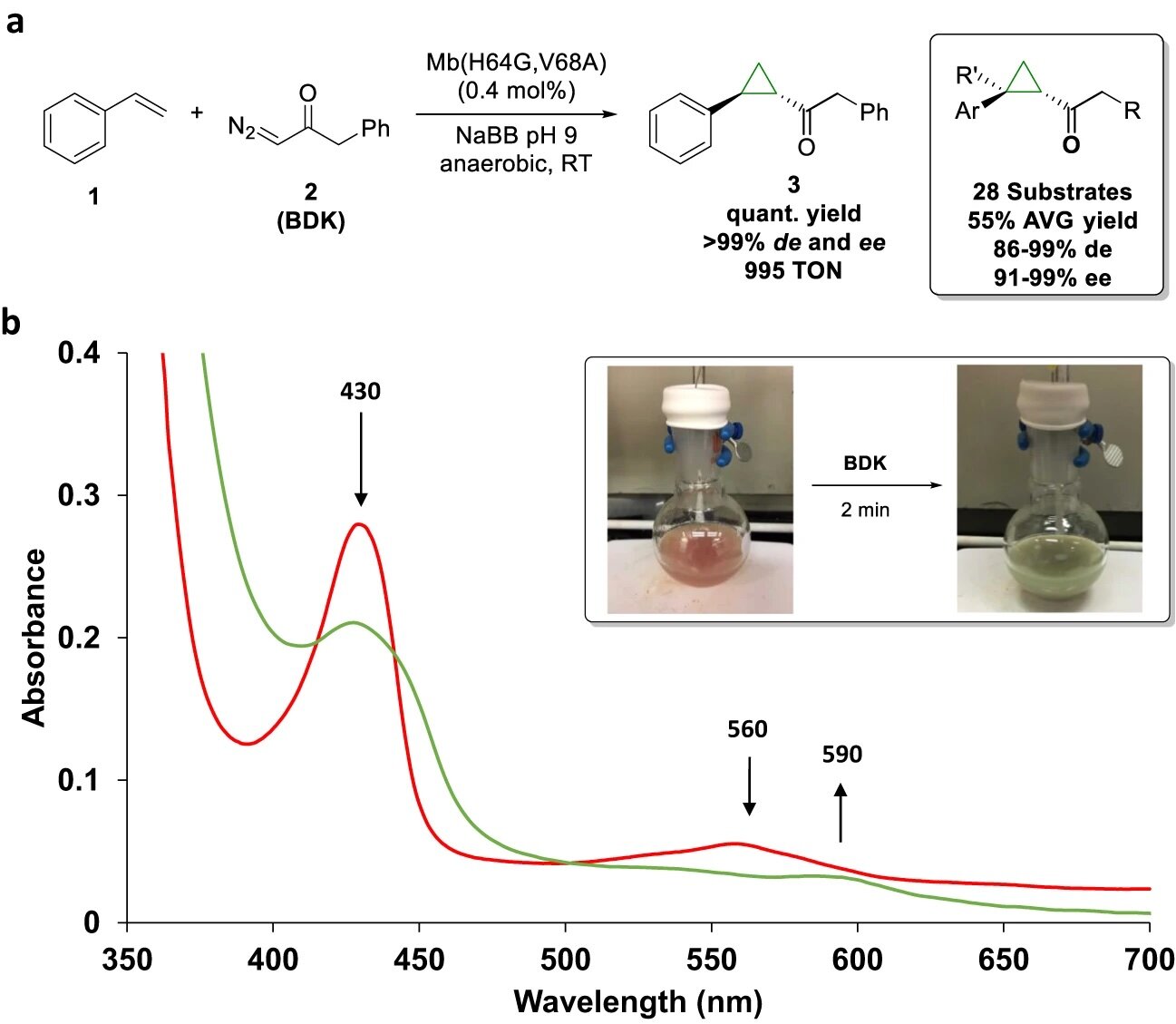Sometimes, serendipity—or just plain luck—still plays a pivotal role in scientific discovery. Recently, a team of chemists was experimenting with using a biocatalytic process to trigger a cyclopropanation reaction, which yields intricate molecular structures used in various drugs and other natural processes, when something unusual happened: A beaker of liquid that should have turned muddy red turned bright green instead.
The team—which grew to include researchers from the Stevens Institute of Technology alongside colleagues from Oxford, Cornell, Rochester, and the University of Texas—has published their explanation of the unusual result in Nature Communications. Their key finding: Even when chemical reactions are apparently well-understood, sometimes nature takes the scenic route.
“It turns out that you can’t assume there’s just one chemical pathway at work,” explains Dr. Yong Zhang, a professor in the Department of Chemistry and Chemical Biology at Stevens. “When we looked more closely, we found that some unexpected and entirely new chemistry was taking place.”
The reaction in question used engineered hemoproteins—like the hemoglobin and myoglobin that store and transport oxygen in our blood and muscles—as the catalyst in a carbene transfer reaction. The goal: to use carbene, an extremely reactive carbon-based molecule, to generate a cyclopropane ring, which could then be used to generate a wide range of useful compounds including a number of important antibiotics.
Using hemoproteins to trigger that reaction is attractive because they contain the abundant Fe as the metal center and are nontoxic, easy to fine-tune, and viable at room temperature.
“That’s exactly what you need in order to manufacture drugs safely and cheaply,” explains Dr. Zhang. “But if it turns out you’re also producing unexpected molecules of other kinds, it could create safety issues or compromise the efficiency of the reaction.”
To understand the unexpected chemical reaction, the researchers used a range of cutting-edge techniques to explore the chemistry at work, including advanced computational methods led by Dr. Zhang. Other research units used techniques such as Mössbauer spectroscopy and X-ray crystallography to characterize molecules at the atomic scale and accurately map the precise structures involved in combination with calculations.
Collectively, the team’s work revealed that while in many cases cyclopropane rings were being formed via the intended hemoprotein-mediated carbene reaction, a number of other complex and unanticipated reactions were also taking place. In some cases, computational methods revealed the possibility of rare side-reactions that required more energy than is typically available in a room-temperature reaction. In others, computational and observational methods identified multiple competing pathways out of which cyclopropanation could occur.
Notably, one alternate pathway led to the formation of a myoglobin variant complex called Mb-cIII—the strange green compound the team had initially found in their beaker. Further research showed that the Mb-cIII complex naturally regenerated the hemoprotein catalysts used in the original reaction, allowing the intended cyclopropanation reaction to continue.
“What we found wasn’t a dead end, but rather a detour,” Dr. Zhang said. “It’s a sign that these important reactions aren’t simple and linear, but rather a complex network of forking chemical pathways.”
The team’s ability to untangle those pathways and describe the full complexity of the cyclopropanation reaction should streamline important future research on carbene-based reactions and biocatalysts, Dr. Zhang says. Crucially, it also shows the value of using both computational and experimental methods to explore chemical reactions, and to ensure that all possible side-reactions are considered when exploring new chemistry.
“As scientists, we need to remain open-minded,” Dr. Zhang says. “If you assume you already understand exactly how these processes work, then you limit your opportunity to discover new things.”
More information:
Donggeon Nam et al, Mechanistic manifold in a hemoprotein-catalyzed cyclopropanation reaction with diazoketone, Nature Communications (2023). DOI: 10.1038/s41467-023-43559-7
Provided by
Stevens Institute of Technology
Citation:
Chemists shows hemoprotein catalysis is way more complicated than we thought (2024, May 10)
retrieved 11 May 2024
from https://phys.org/news/2024-05-chemists-hemoprotein-catalysis-complicated-thought.html
This document is subject to copyright. Apart from any fair dealing for the purpose of private study or research, no
part may be reproduced without the written permission. The content is provided for information purposes only.


